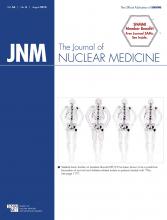PSMA PET in prostate cancer: Jadvar provides perspective on prostate-specific membrane antigen as a biomarker in imaging evaluation of prostate cancer and previews a study on this topic in this issue of JNM.
Page 1131
Quantitative accuracy of PET/CT: Kinahan and colleagues look at the increasing need for precision results in PET/CT assessment of tumor response to therapy and introduce a related article in this issue of JNM.
Page 1133
Imaging T cells: Neri describes current efforts and challenges in imaging T cells in vivo and outlines the novel biomedical opportunities afforded by this capability.
Page 1135
PET/CT repeatability in NSCLC: Weber and colleagues explore the repeatability of quantitative parameters derived from 18F-FDG PET/CT imaging in non–small cell lung cancer and discuss the application of these results in monitoring tumor response to therapy.
Page 1137
PET and tumor fluid penetrance: Lubberink and colleagues assess the effects of imatinib and anakinra on perfusable tissue fraction and tumor blood flow in colorectal cancer metastases using 15O-water PET/CT and kinetic modeling.
Page 1144
Prognosis and pretherapeutic SUR: Bütof and colleagues investigate whether 18F-FDG PET imaging can provide independent prognostic information in patients with inoperable esophageal carcinoma and whether the tumor-to-blood standard uptake ratio can enhance the quality of this information.
Page 1150
Intraarterial hepatic SPECT/CT: Gates and colleagues demonstrate typical and atypical findings of 99mTc-MAA distribution on SPECT/CT obtained as part of pretherapeutic planning for radioembolization with 90Y microspheres.
Page 1157
PET/CT in pancreatic cysts: Kauhanen and colleagues compare the accuracies of combined 18F-FDG PET and contrast-enhanced CT, multidetector CT, and MR imaging in differentiating malignant from benign pancreatic cysts.
Page 1163
68Ga-/177Lu-PSMA theranostics: Weineisen and colleagues describe development, preclinical evaluation, and proof-of-concept investigation of a prostate-specific membrane antigen inhibitor for imaging and therapy in patients with metastatic and castration-resistant prostate cancer.
Page 1169
PET/CT and survival after 223Ra: Etchebehere and colleagues evaluate outcomes after 223Ra-diochloride therapy for hormone-refractory prostate cancer and determine whether skeletal tumor burden on whole-body 18F-fluoride PET/CT is prognostic for survival.
Page 1177
18F-fluoromethylcholine vs. 68Ga-PSMA: Morigi and colleagues compare the detection rates of a 68Ga-prostate-specific membrane antigen agent and 18F-fluoromethylcholine in PET/CT in men initially managed with radical prostatectomy, radiation treatment, or both who were being considered for targeted therapy.
Page 1185
PET/CT, MTV, and endometrial cancer: Husby and colleagues explore the value of 18F-FDG PET/CT for preoperative staging in endometrial carcinomas and the correspondence of 18F-FDG PET–specific quantitative tumor parameters, including metabolic tumor volumes, to clinical and histologic characteristics.
Page 1191
PiB R1 as CBF proxy: Chen and colleagues assess the suitability of 11C-Pittsburgh compound B blood–brain barrier delivery and relative delivery parameters as surrogate indices of cerebral blood flow in mild cognitive impairment and Alzheimer disease.
Page 1199
Red nucleus metabolic activity: Hirata and colleagues use a high-resolution semiconductor PET system to investigate the metabolism of the human red nucleus and its correlation to other brain regions.
Page 1206
Current practices in V/Q scintigraphy: Le Roux and colleagues survey current clinical standards of practice in Australia, Canada, and France for ventilation/perfusion imaging in evaluation of suspected acute pulmonary embolism.
Page 1212
Fetal 18F-FDG dosimetry: Zanotti-Fregonara and colleagues estimate fetal radiation doses from 18F-FDG in a series of pregnant women who underwent PET imaging during clinical workup for malignancies.
Page 1218
Quantitative imaging of hypoxia: Muzi and colleagues test the validity of using image-derived tissue regions that are highly correlated to blood levels as an alternative to serial blood sampling in 18F-FMISO PET assessment of hypoxia.
Page 1223
Upper gastrointestinal motility studies: Maurer provides the first of 2 educational overviews of gastrointestinal scintigraphy, focusing here on esophageal transit and gastric emptying.
Page 1229
RIT with cetuximab in CRC: Vassileva and colleagues evaluate the preclinical efficacy of combination radioimmunotherapy, using a humanized 131I-labeled anti-carcinoembryonic antigen antibody and cetuximab in colorectal cancer.
Page 1239
Imaging periostin for cancer invasion: Heidari and colleagues develop and characterize a PET tracer that specifically targets the extracellular matrix protein periostin and evaluate this probe in preclinical models of esophageal squamous cell carcinoma.
Page 1246
TBI and 64CuCl2 PET/CT: Peng and colleagues report on the potential of this copper-based PET imaging agent as a biomarker for experimental traumatic brain injury in mice.
Page 1252
Immuno-PET and T cell reconstitution: Tavaré and colleagues detail the generation of anti-CD4 and -CD8 cys-diabodies derived from parental antibody hybridomas for 89Zr-immuno-PET detection of helper and cytotoxic T cell populations.
Page 1258
PET and tumor-associated macrophages: Blykers and colleagues explore the identification and 18F-labeled antibody fragment PET assessment of M2-oriented tumor-supporting macrophages within the tumor microenvironment as indicators of cancer progression and prognosis.
Page 1265
89Zr-HDL tumor-associated macrophage imaging: Pérez-Medina and colleagues describe the development of reconstituted high-density lipoprotein-facilitated tumor-associated macrophage PET imaging in a preclinical breast cancer model.
Page 1272
PET/NIRF assessment of quantum dots: Hu and colleagues report on a dual receptor–targeting dual-modality PET/near-infrared fluorescence probe for accurate assessment of the pharmacokinetics and tumor-targeting efficacy of semiconductor quantum dots.
Page 1278
Isotopes, image quality, and hybrid scanners: Soderlund and colleagues investigate image quality for 18F, 11C, 89Zr, 124I, 68Ga, and 90Y on PET/CT and PET/MR clinical scanners.
Page 1285
- © 2015 by the Society of Nuclear Medicine and Molecular Imaging, Inc.







